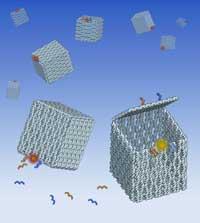The greatness of the smallest in season
For example, researchers from this Australian university have published in the journal Nature an article in which they have managed to significantly increase the storage capacity of information by using gold nanoparticles. In conventional DVDs, the information is read by laser, that is, by a wavelength or monocolor light. The characteristics of nanoparticles allow researchers to use different wavelengths or colors, without interference in the recording and reading of information in the same place.

DNA boxes are one of the most striking examples of
nanotechnology (Photo: Ebbe Sloth Andersen)
On the other hand, depending on the orientation of nanoparticles, they absorb one or another polarized light. Researchers have explained that polarity can rotate 360º. Therefore, in a polarization of 0º one can record one information and another, for example, in a polarization of 90º, all in the same layer. In addition, a disk can have multiple layers.
Thus, researchers have qualified as "five-dimensional disks". They have recognized that they should still improve aspects such as disc recording speed. However, 5D discs are expected to be on the market within 5-10 years.
Meanwhile, there will be more news from universities and research centers working in this field. And not only in this area. Numerous research on DNA nanostructures has recently been published.
DNA raw material
In fact, this field is also very interesting and they are getting amazing structures based on the so-called life molecule. For example, at the Tata Institute for Basic Research in Bangalore, India, an indicator has been developed to measure the acidity of pH 7 to pH 5 using three DNA fragments. These DNA indicators work in living systems, even within the cell. This is very useful as cell pH changes are related to diseases.
Another DNA application has been developed at the University of New York (USA). Its researchers have managed to move a DNA engine in the desired direction. For this they have made a path, also DNA, which serves to move the DNA motors in a certain direction. According to researchers, these DNA engines can be used to "bind complex molecules or to transport drugs and molecular machines in the body."
But perhaps the most striking structures of DNA are the DNA boxes. The keys that open the boxes are also DNA! They were made at Aarhus University in Denmark. Based on the DNA of a virus that infects bacteria, they have created a computer model. With this model one billion DNA boxes are formed in 2-3 hours.
As already mentioned, the boxes are opened with DNA: if a certain gene or sequence is placed on a box edge, the box opens. This may be appropriate for transporting medicinal molecules to specific locations, as it would not open up to find the corresponding DNA sequence and join it.
On the other side of these seemingly science-fiction examples are the concerns of those who see more dangers than opportunities in nanotechnology. And it is true that, like all technology, it has risks. However, it is also being investigated and it will take time to see which side the balance is crouching.
Published in Gara
Buletina
Bidali zure helbide elektronikoa eta jaso asteroko buletina zure sarrera-ontzian











